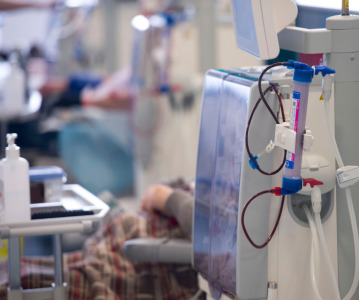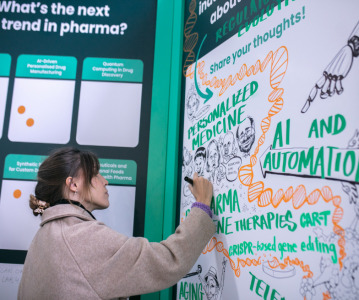Diabetes diagnosis - now a matter of sweat and tears?

No need to draw blood; researchers develop smart technology to diagnose diabetes and treat diabetic retinopathy.
A research team from POSTECH has developed technology that allows diagnosis of diabetes and treatment of diabetic retinopathy just by wearing ‘Smart Light-emitting diode (LED) Contact Lens.’
Professor Sei Kwang Hahn and his research team have invented a smart photonic contact lens and a wearable medical device which can diagnose diabetes and treat diabetic retinopathy. Their new research results on photonic diagnosis and photonic therapy of diabetes are published on-line in Nature Reviews Materials in collaboration with a research group led by Zhenan Bao from Department of Chemical Engineering at Stanford University and David Myung from Stanford Medicine Ophthalmology.
The smart contact lens with integrated micro-LED and photodetector can measure glucose concentration in the conjunctival blood vessels by analysing the NIR light which, in turn, helps with diabetic diagnosis.
The team applied its new smart LED contact lenses to rabbits with diabetic retinopathy disease and irradiated light repeatedly for a month. This resulted in a significant reduction of angiogenesis (production of new blood vessels) in the retina and verified clinical feasibility of the smart LED contact lens for the diabetic retinopathy therapy.
This newly developed device will allow diabetic patients to monitor their blood-sugar level in real-time; it also enables medical treatment for retinopathy which is caused by diabetic complications.
Meanwhile, Professor Hahn and his research team have also developed a smart contact lens that can diagnose diabetes by analysing glucose concentration in tears and deliver drugs to treat diabetic retinopathy. Preliminary clinical tests for the developers are expected to be done in the first half of this year.
On the basis of these results, they have also developed a smart wearable medical device that can analyse glucose concentration in sweat and they verified, which could also be clinically feasible for diabetic diagnosis. Furthermore, in conjunction with PHI Biomed, they developed a blue-tooth system that can send data wirelessly allowing patients to check their diabetic diagnosis results on their mobile phones.
Professor Hahn commented: “We developed a smart LED contact lens that can diagnose diabetes and treat diabetic retinopathy with light for the first time in the world. We are planning to commercialize these smart contact lenses and smart wearable medical devices in collaboration with Stanford Medicine.”
Related News
-
News US FDA adds haemodialysis bloodlines to devices shortage list
On March 14, 2025, the US FDA published an open letter to healthcare providers citing continuing supply disruptions of haemodialysis bloodlines, an essential component of dialysis machines. -
News Vertex Pharmaceuticals stock jumps as FDA approves non-opioid painkiller
UK-based Vertex Pharmaceuticals saw their stock shares soar as the US FDA signed off on the non-opioid painkiller Journavx, also known as suzetrigine, for patients with moderate to severe acute pain, caused by surgery, accidents, or injuries. -
News Lessons from CPHI Milan 2024: Sunny Intervals for Pharma Manufacturing?
As the 2024 CPHI conference wrapped up in Milan, we caught up with L.E.K. Consulting – a global strategy consulting firm with deep expertise in pharma manufacturing – to discuss evolving market perspectives and business outlook. -
News US BIOSECURE Act passed by US House of Representatives
The controversial act, which has already impacted several foreign companies operating in the US, was passed by the House of Representatives on September 9, 2024. It is now headed for the US Senate before it can be signed into law by President Joe Biden... -
News Pharma Supply Chain People Moves
The latest appointments, promotions, and structural changes across the pharmaceutical supply chain. -
News Drug prices agreed upon as part of the US Inflation Reduction Act
The Inflation Reduction Act brought into constitution by the Biden administation in 2022, which proposed a drug price negotiation between the government and pharmaceutical companies, has reached it's first agreement. -
News BIOSECURE Act continues to loom over Chinese pharma manufacturers
With the US BIOSECURE Act on its way to passing into legislation, Chinese companies are facing declining revenues within the first half of 2024 as US pharmaceutical and healthcare companies pull their businesses from the country. -
News Ophthalmologic drug product Eylea faces biosimilar threats after FDA approvals
Regeneron Pharmaceutical’s blockbuster ophthalmology drug Eylea is facing biosimilar competition as the US FDA approves Biocon’s Yesafili and Samsung Bioepis/Biogen’s Opuviz.
Position your company at the heart of the global Pharma industry with a CPHI Online membership
-
Your products and solutions visible to thousands of visitors within the largest Pharma marketplace
-
Generate high-quality, engaged leads for your business, all year round
-
Promote your business as the industry’s thought-leader by hosting your reports, brochures and videos within your profile
-
Your company’s profile boosted at all participating CPHI events
-
An easy-to-use platform with a detailed dashboard showing your leads and performance






.png)
.png)